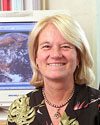Science communication pioneer Judy Jackson retires
 |
| Judy Jackson
|
When Judy Jackson began working at Fermilab in 1991, she planted seeds for more open and transparent communication. More than 20 years later, her efforts continue to bear fruit for Fermilab and the particle physics community worldwide.
"She has broken completely new ground regarding the way that science is communicated," said Neil Calder, former SLAC National Accelerator Laboratory head of communications and Jackson's long-time colleague.
Jackson will retire next month. Thursday is her last day at the laboratory. A retirement celebration for Jackson will take place at 4:30 p.m. on Thursday, Jan. 27, on the second floor crossover of Wilson Hall. Come congratulate Jackson on her retirement.
"It has been enormous fun," Jackson said.
Since she began working for Fermilab as a contractor in 1991, and then as an employee in 1992, Jackson has taken a creative approach to communication, often thinking outside the box and occasionally going against the grain.
Calder was working in the CERN press office in 1996 when he first heard from Jackson. There was an atmosphere of contention between the two laboratories and Calder had issued a press release stating that a CERN experiment had at last begun producing large numbers of W bosons.
Jackson, who became director of the Office of Public Affairs in 1995, called Calder to explain that Fermilab had produced buckets of W bosons for years and invited him to visit.
"We got on very well and determined that Fermilab and CERN would work together to make sure that there were no more stupid mistakes," Calder said.
The collaboration between the two laboratories continued, and Jackson began reaching out to communicators at other laboratories.
"Judy wanted the laboratories to work together rather than against each other," Calder said.
In 2001 Jackson led the formation of the InterAction Collaboration, an international particle physics communication group dedicated to promoting particle physics and their institutions. The collaboration began with six laboratories: DESY, Fermilab, CERN, SLAC, INFN and Gran Sasso; and today it includes 22 institutions worldwide.
Read more
|